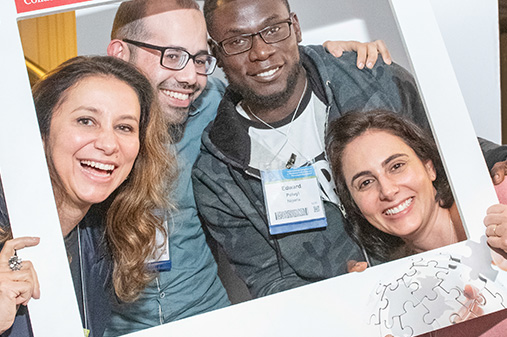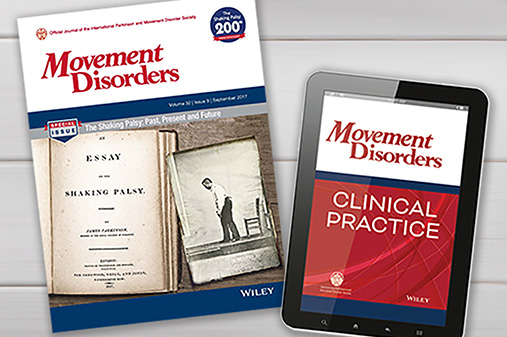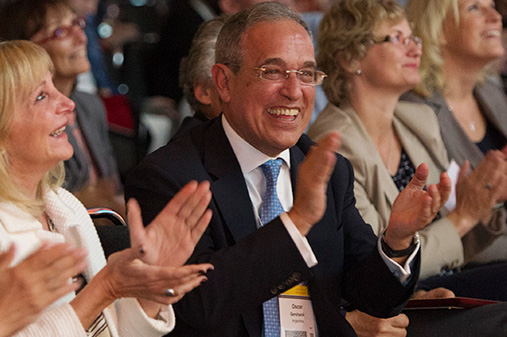Hot Topic: Pallitive care in movement disorders
Dr. Sarah Camargos: [00:00:00] Welcome to the MDS Podcast. The official channel of the International Parkinson and Movement Disorder Society. I am your host, Sarah Camargos, and today we are launching the very first episode of our Hot Topic series, where we'll be talking about palliative care in movement disorders. To explore this important topic, I am delighted to have with me Professor Janis Miyasaki from the University of Alberta, who was the first chair of the MDS Palliative Care Study Group.
View complete transcript
Professor Miyasaki, thank you so much for joining us.
Prof. Janis Miyasaki: Oh, thank you for having me, Sarah.
Dr. Sarah Camargos: I think professor, many people still associate palliative care with end of life care, but in reality it's much broader than that. Could you tell our listeners what palliative care really means in the context of movement [00:01:00] disorders?
Prof. Janis Miyasaki: Palliative care does involve end of life care, but we've also morphed it into really the, from the beginning of a diagnosis. And palliative care is really about a philosophy of care. It puts the patient at the center of our focus with their family, and it asks the patients what are their goals. I think in movement disorders, we love our scales, right?
We have a scale for everything, and sometimes it doesn't capture everything that is of importance to a patient. We often do not touch on how is this diagnosis affecting their identity, their roles in society, in their, with their family, in their community, and how much distress this can cause for them.
And so palliative care seeks to [00:02:00] address those symptoms as well. And puts an emphasis on team-based care, which movement disorder clinicians are very accustomed to, but maybe broadening our definition of who should be included in that team. And some of the things that maybe neurologists aren't so good at, which is talking about feelings, talking about existential distress.
And realistically, most of us are not trained to do that. And so including team members who can focus on that, whether it's a social worker, a psychologist, or psychiatrist, or in the case of my clinic, we have had a palliative care psychologist involved in the care of our patients, and that has really been invaluable, both for the patients and the family.
Dr. Sarah Camargos: I agree. In a paper developed by the task force, you conduct a [00:03:00] survey among MDS members. And received almost 700 responses. What really got to my attention was the vast majority of them recognize the role of palliative care in movement disorders, and many also express a desire to develop skills in this area.
Why do you think there's such a growing interest among clinicians in integrating palliative care into their practice?
Prof. Janis Miyasaki: The reason why I think our clinicians are interested in adopting palliative care principles is because to me, palliative care is the best of medicine. When we do the interviews for young medical students, they often talk about relieving suffering. And when they talk about relieving suffering, they don't just mean, relieving one symptom, making them move a little faster.
They mean all of the person. And somehow during our [00:04:00] training it gets taken away from that and really targeting algorithms and checklists and we lose some of that wide eye idealistic approach to helping all of the person. And so I think our movement disorder clinicians are actually expressing, you know, I do a great job with many aspects of our conditions, but there's still something missing. There's something I feel I could do better, especially for those who, clinicians who are dedicated to following their patients throughout the course of their illness. I think unfortunately there is a movement towards diagnosing the patient and sending them back to their primary care physician. But I think that really as movement disorder neurologists, we understand the trajectory of our patients.
We understand the complications that they experience, [00:05:00] and we see these patients who come to us often, captains of industry, high functioning people and we see that deterioration and we cannot of course help but be affected by these losses that our patients are experiencing and that we can also to some extent identify with how painful it would be if we lost these abilities.
And then I would like to say that the neuro palliative care community has been very effective at conducting research that provides good evidence because it's one thing to say, do this. It's nice, it makes people happy, but it's another thing to actually say when you do this, caregiver burden is reduced.
The distress that people experience is less, and that even though [00:06:00] we were not targeting changing their medications, their movement disorder symptoms got better.
They also felt they had more knowledge and more ability to see what the future would look like, and they felt they were given a roadmap to help 'em plan for the future.
And so I think the ability of Dr. Kluger and I and many other researchers to provide this information has allowed people to see, wow, we could be doing better. And it doesn't require, you know, a big fancy building. It requires all of us undertaking these palliative care skills and bringing them to our clinic.
And if we have the palliative care workforce in our community available, engaging those palliative care teams. So, Benzi had [00:07:00] this wonderful study where we were incorporating palliative care into centers of excellence. And we provided coaching, both Benzi Kluger, myself and Christina Vaughn. And many of the coaching was about how do you get a team behind a change in behavior when they're already feeling strained?
How do you incorporate some of these palliative care skills, which are really excellent communication skills? And that doesn't mean doing a data dump. But really hearing what the patients are saying to you and accepting what the patients are saying to you and trying to help them meet their goals. So I think all of this work has opened people's eyes to a different way of being with patients and I think it's extremely fulfilling when you have great conversations [00:08:00] and the patient says, I really felt heard.
Dr. Sarah Camargos: Yes, your talk is compelling and you proved through clinical trials that it's different when it comes to palliative care. The patients get better and the family gets better. It's well proven. We don't have a doubt.
Prof. Janis Miyasaki: In fact, even in illnesses that we consider fatal, like metastatic cancer, they have shown that people who were randomized to palliative care out survived the people who were not receiving palliative care. And one of the theories behind that is because, the palliative care teams listened to how the patients were experiencing their chemotherapy and were able to reduce side effects and morbidity for the patient.
And so again, it's one [00:09:00] thing to keep someone always in the on state, but if they're actually hypomanic and impulsive, that overall balance of their life is just out of whack.
Dr. Sarah Camargos: And it's different because oncology patients usually receives palliative care, but we don't refer our neurology patients to palliative care.
Prof. Janis Miyasaki: I'm going to challenge that because in fact my palliative care colleagues say there are some clinics that never refer to them from the cancer institute.
Dr. Sarah Camargos: Really?
Prof. Janis Miyasaki: Yes. And so I think as physicians, we have to change our philosophy as we see our patients declining, that this is a failure, but rather this is part of life.
And we have done so well just think about how movement disorders has changed. We can give them deep brain stimulation. We can lesion the patients, we can give them [00:10:00] infusions.
We can really enhance their quality of life for so many decades. And that was not possible when I started. And so when you think about that as they decline, rather than seeing it as a failure we should acknowledge that there are limits to what modern medicine can do at this time. And that our responsibility to these patients is that we do our best to relieve their suffering and to help them find joy even in the midst of their suffering.
It is possible.
Dr. Sarah Camargos: There are options, but maybe most of them aren't aware of the choices they have. You mentioned that we like clinical scales. I would challenge you right now with is there any validated to guide, to help clinicians [00:11:00] decide when refer a patient to palliative care?
Prof. Janis Miyasaki: The referral criteria for palliative care is challenging because it is really based on the palliative care workforce
And how comfortable they feel. And so I, in fact, last fall was with the Hong Kong Health Authority, helping them look at how do we develop a palliative care referral pathway for their patients because they really wanted to incorporate palliative care for all of neurology and it really requires the palliative care physicians and teams to be involved in that process. Because they will let you know how much volume they can accept and where they feel impactful.
I think at first if a palliative care team is not very accustomed to neurology [00:12:00] patients, they're scared, like neurology is scary to non neurologists, and so they feel intimidated. Also, many of our patients have cognitive issues or communication problems, and they are used to being able to talk to their cancer patients and get feedback about how they're doing, whether a treatment works or not.
And so this requires a little bit of extra thought to determine whether their interventions are working and to understand the impact. And again, I think it was our clinical trials that showed patients were doing better even after one year. That allowed the palliative care teams to say maybe we've been closed to neurology.
Maybe we should open up and we can have impact. And so I would say, Sarah, that if a group wants to establish a pathway, [00:13:00] it's really essential to speak to your palliative care colleagues. And what I encourage people to do is to not just say, Hey, we got patients for you. Take them. But also to think, because most movement disorder centers are in an academic institution, and so your palliative care colleagues will also be academic to think about what are the research opportunities for the two of you to collaborate on? How can you give placement opportunities for their trainees and for your trainees to go to them so that they feel there is this collaboration and cooperation? For example, I sit on the palliative care residency match committee. And I think that is my service to recognize how much effort my palliative care colleagues put forth for [00:14:00] our program. And so I think we have to recognize there is a relationship building phase, a trust phase, and also to give the palliative care colleagues an opportunity to say, you've been sending a lot of these patients and we're not really sure what to do, or we're not sure we can help. And I think the other is, we have to be courageous and have hard conversations sometimes with our patients, and it is not fair to leave those hard conversations only to our palliative care colleagues.
Dr. Sarah Camargos: Sure. But in one of your publications, I realized that in the appendix there are a lot of good communications, sentences to open conversation with you and your patient. And this is really nice because we were not [00:15:00] educated for this kind of conversation. So this can guide us through the initial steps with our patients.
Prof. Janis Miyasaki: I agree, Sarah. We weren't really taught to have that kind of talk. We were taught to get in there, make the diagnosis, rather than talking about these longer term issues that are of prime importance to our patients and our patients can sense. If you want to talk about it and you're open to it or you do not wanna hear it, they can tell.
Dr. Sarah Camargos: And who are do you think are the key health professionals that usually play a role in the palliative care for movement disorders?
Prof. Janis Miyasaki: The team can be as large and then as complex as you want to make it. And I would say I have had a different [00:16:00] experience because when I started my program in 2007, there was zero funding for it. So essentially I had to try and engage people with their discretionary time to come and see our patients.
And so I first invited palliative care colleague to attend my clinic and at the end of two clinics she said, wow, your patients suffer a lot. They need palliative care. And so that was how she gave a day a week to my clinic. And how I got my first spiritual counselor was a woman whose uncle had been a patient of our clinic, not my patient, but she came up to me and said, you don't know who I am and you don't know what I do, but you need me.
And so I [00:17:00] said, are you free? And she said, yes, I am free. And I said, great. You're part of the team. And so I think people are under the perception that everything was given to me or that the government fully funded this clinic. In fact, it was stupid luck, but also the generosity of my colleagues and for them to see how much our patients suffer.
And I would say that is a repeated occurrence that when I moved to Edmonton, I cold called a government official and sent a paper that I had written and she said, oh yes, this is a great idea for our patients. Let's make it happen. And so it became easier once I had published something. And I would say as well that when my patients started being admitted to the inpatient palliative care unit, [00:18:00] which they had been forbidden from being admitted to before because they would survive too long, the first palliative care doctor called me and said.
Your patient suffers so much. Is this what they are all like? And I said, yes. And she said, where have they been? I have never seen a patient with this diagnosis in my entire training. And I said, they're here, but a lot of people marginalize them and they need your help, and it was eye opening for her to realize there was this group of people in the community with their families just trying their best, but really knowing they were unable to meet the needs of their loved ones.
And so now we are able to have these patients admitted. We also manage them very well in the community because we're so lucky to [00:19:00] have a community palliative care service. And so I think it's up to every unit to determine what are the services available in their community to create a good relationship and to then develop what is a realistic referral pathway.
Because here we have an established referral pathway because now there are three palliative care doctors who understand neurodegenerative disease.
Many communities will not even have that kind of workforce to do that. And so you have to build it up. And I would say to those of you who say, oh, that sounds like it's gonna take a lot of time. I started talking about this in 2005. I got my first grant in 2007. And so it's taken that long to make people say, wow, this is a good idea. [00:20:00] And just like anything in medicine, worthwhile things are hard, but we in movement disorders are used to doing hard things and we can do it.
Dr. Sarah Camargos: And do you think the main challenges clinicians face when addressing palliative care needs are a lack of education or lack of money? What do you think are the main challenges to address people to palliative care.
Prof. Janis Miyasaki: The World Health Organization estimates that only 25% of people who need palliative care receive it. And they feel that much of the inability to access palliative care is one just basic access to medications that would help, such as opioids. Many countries do not have opioids on their [00:21:00] list of essential drugs or heavily restricted. And in the case of our patients, when they need it. The other is of course, workforce. Many countries are struggling just to maintain an adequate workforce for hospital care, let alone community care, which is most of movement disorder care occurs in the community. And I think that this is a challenge even in countries that are heavily committed to socialized healthcare or universal healthcare.
Yeah. Can we change that? It is a challenge even in countries that are heavily committed to universal healthcare to manage a diverse enough workforce to provide palliative care to all people who would benefit neurology patients comprise currently about 3% of all the patients who would [00:22:00] benefit from palliative care according to the World Health Organization.
I think it's a bit more, but when you think about it, it's like chronic obstructive lung disease, all the cancers, congestive heart failure, renal failure. There are so many conditions that could benefit from palliative care and don't have access to it. And so I would say the programs in subspecialty medicine that thrive are the ones where there is a champion who is committed to partnering with palliative care colleagues, and the palliative care colleagues will respond by committing their time and effort to programs.
And so it, to me, a lot of it is that commitment to being a true partner with palliative care.
Dr. Sarah Camargos: Yes I'm curious about one thing, [00:23:00] not everyone who chooses assisted dying has access to palliative care. If they had the opportunity to receive proper palliative care, do you think their decision might change or at least be postponed?
Prof. Janis Miyasaki: As you know, Sarah, in Canada we have had medical assistance in dying for many years. And after cancer, neurology conditions are the next most common cause for someone to request medical assistance in dying. I, in fact, wrote an opinion piece about why is it legislated that patients have to have a ready, easy to navigate pathway to medical assistance in dying, but not an easy pathway to palliative care. And so in fact, in our medical assistant in dying form the physicians have to indicate that the [00:24:00] patient was offered palliative care. But that is just offered, and I think as you mentioned early on, people have a misconception about what it is. In fact, some people come to our clinic and say, I don't believe in assisted dying.
And we said, that's not what our clinic is for. So, I agree. I think that there is a marginalization of palliative care when we talk about medical assistance in dying or euthanasia that, people probably don't understand. It's a whole different philosophy of care. And many people who come to our clinic say, this is the most care I've ever gotten, or I feel really heard and seen, or the relatives say This has been helpful for me.
So [00:25:00] the reframing of what suffering is, the reframing of how we can address suffering and also the emphasis on finding joy and meaning is really so integral to palliative care. And I feel that people who do not at least have a visit or several visits with a palliative care team are missing out on what their life could be because I think the motto for palliative care should not be a good death.
It should be, palliative care is about living well now.
Dr. Sarah Camargos: I agree. I could not agree more. It's perfect. What message would you like clinicians and families to take away from your work in palliative care?
Prof. Janis Miyasaki: I think the main [00:26:00] focus of all my research, Sarah, has been the patient and family. In particular for the family, however that family looks. It could be neighbors, it could be former coworkers. People bring in all variations of family, but that is their family. And to recognize the contribution that these families make to our patients' lives.
And the often challenging things we ask them to do. How many papers about the behavioral changes in Parkinson's disease really address what the caregivers undergo? So I would like them to hear the message, that our patients and families should be at the center of our care, that in the face of these [00:27:00] conditions that are very debilitating, there can still be great joy and meaning, and that our role for many of our patients is to walk alongside them. And that in itself has a great power for our patients because they have too often heard, there is nothing more I can do for you, and that is not true. And so for our colleagues, my message would be, I hope no patient ever hears those words. There is nothing more I can do for you. I hope they hear. Instead, I will walk with you this entire journey.
Dr. Sarah Camargos: And I would try to reduce your pain.
Prof. Janis Miyasaki: Yes, because suffering has so many different faces and so many different [00:28:00] causes, and we should be here to accept it all.
Dr. Sarah Camargos: Yes. Wow. Professor Janis, I have no words to thank you for the opportunity of interviewing you and I almost cried with your words. It's amazing. Your job is really amazing. And the interesting thing is that I put meaning here when I was drafting the interview, I think people should seek for their meaning. And you said this word a lot of times. So thank you so much.
Prof. Janis Miyasaki: Thank you, Sarah. [00:29:00]

Janis Miyasaki, MD, MEd, FAAN
University of Alberta
Edmonton, Canada









